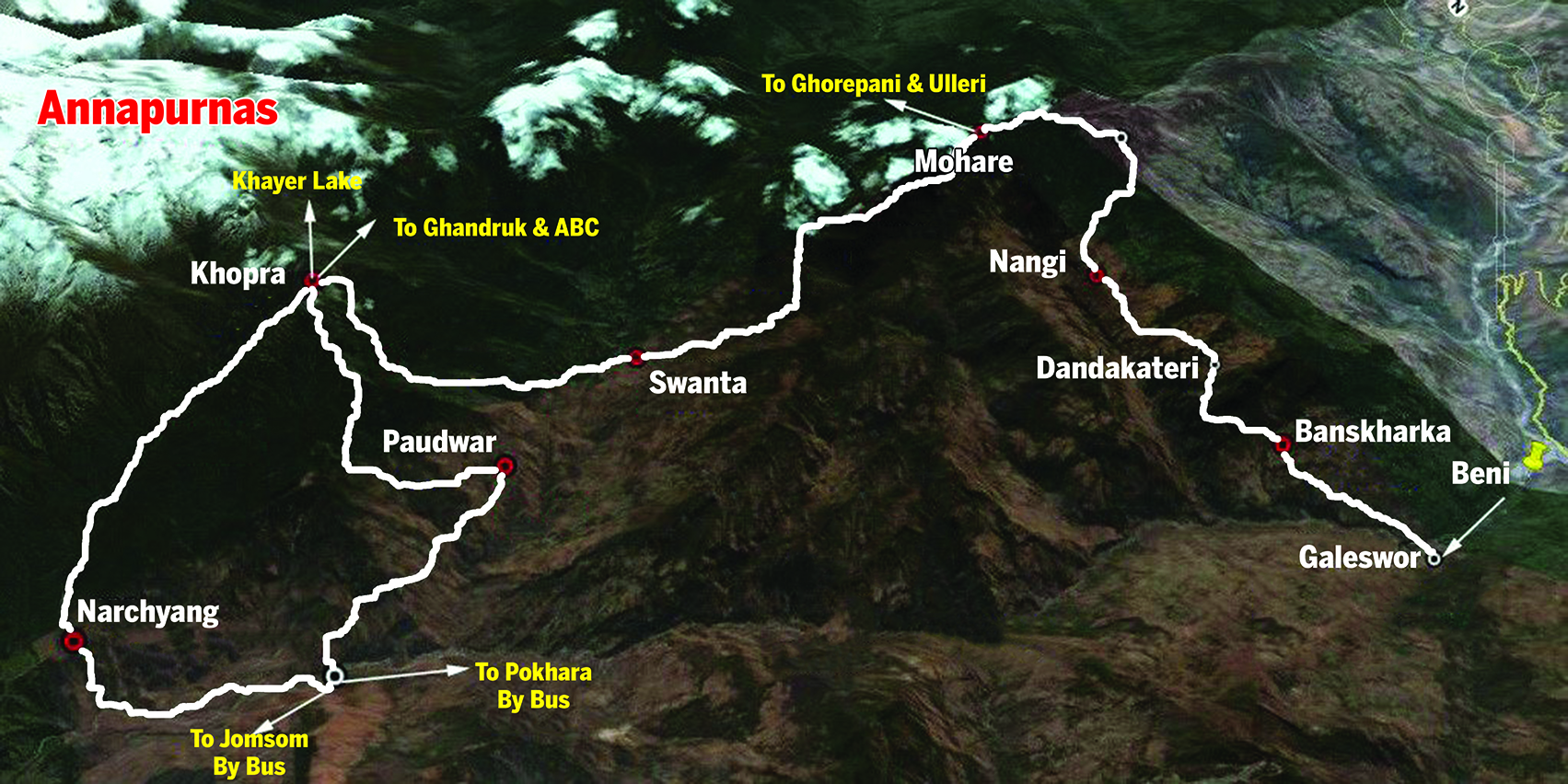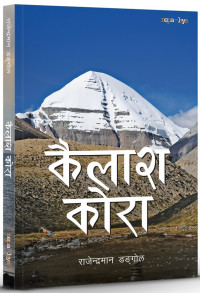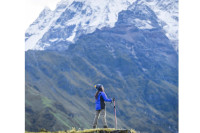Travel
Khopra-Khayerbaraha trekking trail is most famous for monsoon trek. But it’s a trail for all seasons.
Monsoon has brought the Nagi-Mahare-Khopra-Khayerbaraha trekking route alive in a riot of colours..jpg&w=900&height=601)
Ghanshyam Khadka
Nagi-Mahare-Khopra-Khayerbaraha trekking route is a new addition to the several such routes across the Annapurna Region. It’s a trail open for all seasons but is most suitable and fun during the monsoon, say trekkers. Walking across the trail while soaking in the rain is quite a thrill.
Why trek through this trail especially during monsoons, you ask? Suffice it to say, that nowhere else will you experience the sheer power with which nature reigns supreme. Lekali Buki Ful, an indigenous wildflower, blooms in this season in the highlands blanketing the entire trail in a riot of colours.
There are a host of things that visitors can do while on this trail—but first, take in the perfect view of the fresh rays of the sun kissing the peaks of Annapurna and Dhaulagiri, or the sun descending behind these snow-capped mountains as dusk sets in. Along the way, there are several hangout junctions with distinct features—yak farms, ponds, lakes and biodiversity—take some time out and explore the area while on the trail.
Nagi-Mahare-Khopra-Khayerbaraha trekking route starts from Ghumaune Tal, some four kilometres north from Beni, the district headquarters of Myagdi district. A three-hour uphill trek from Ghumaune, visitors reach Banskharka, located at 1,526 metres high from sea level. This is where the first day’s trek ends. Banskharka hosts plenty of community lodges and homestays making it the perfect rest stop before you move further.
.jpg)
After moving upward from Banskharka for five hours through Salleri forest, you’ll reach Nagi Gaun (2,320 metres), which too has a few community lodges and homestays. Nagi Gaun is predominantly a Magar settlement, so one can expect to get a glimpse of the unique, indigenous cultural extravagance of the Magar community. Majority of trekkers spend their second night here.
Pun, Tilija, Khorja, Garbuja, Paija, Sherpuja among other Magar communities are the “locals” of this village. The villagers give you a look into their culture through their songs—Yanimaya, Sunimaya, Sorathi, Jhyaure and Sirful—which talks about everyday life to philosophy that’s better understood through music.
Here on, it’s all the way up. A four-hour trek uphill from Nagi Gaun takes one to Mohare Danda (3,300 metres) through Dhimi Danda. Mohare Danda provides an excellent view of the famed Annapurna-Dhaulagiri Mountain Range, while also making a vantage point to watch the sunrise and sunset. Mohare is also noted for its diverse fauna, especially birds, a perfect venue for ornithology students. Among several endangered species of birds, the usual suspects like Dafne, Monal and Kalij rule the forests here.
On the fourth day, prepare yourself for a six-hour downhill walk to Swanta (2,270 metres). You can start your day with a light breakfast and stop for lunch at one of the three hotels in Swanta. Try out a Dhido set with local chicken or rabbit’s meat.
.jpg)
On the fifth day, a three-hour uphill climb will take you to Aahalkharka. Here, you can sit down for lunch at a community dining hall which will put you right in the middle of a great company of fellow trekkers and locals.
Your next stop is Dhandkharka, which lies at 3,026 metres above the sea level, some three hour’s trek from Aahalkharka. There is only one single community lodge in Dhandkharka, with a capacity of 20 beds. After a good night’s rest in one of these comfortable beds, you can then resume your trek up to Khopra. Be prepared to reach an elevation of 3,660 metres, which means you’ll be walking uphill for four hours.
Once in Khopra, feast your eyes on mountain ranges Annapurna, Baraha and Nilgiri. You’ll also get a bird’s eye view of rural hamlets like Ghodepani, Shekh, Ghar, Khiwang, Dowa, Tatopani and Dana.
Khopra houses many homestays and a community lodge to cater to trekkers and visitors. “We receive at least 10,000 visitors in a year and the number has been increasing of late. The rural municipality has made a policy to add more hotels in the area as the community lodges and homestays are not enough to accommodate the growing number of visitors,” said Nabin Pun, manager of Khopra Community Lodge. “During peak trekking seasons, we prepare makeshift beds in the sheds for lack of space indoors.”

A steady climb uphill for about six hours from Khopra will take you to your final stop, Khayerbaraha Lake at 4,638 metres. There are no hotels or homestays on this route so you’ll have to carry your own food, given the long duration of this particular section of the trek.
The revered Khayerbaraha temple which stands near the lake comes alive every year in Janaipurnima, with a religious fair. At the fair, villagers sell all kinds of knick-knacks, local delicacies, mementoes you can take back home, and even livestock. For farmers, this once-in-a-year fair turns into an opportunity to make some money. “I sold sheep and goats worth around Rs 100,000 during Janaipurnima fair this year,” said Suk Bahadur Tijila, a local of Khayer Khel.
“The trek to the lake is a steep one,” said Raju Pun, a social campaigner. “The further up you move in the high hills, the higher the risk of altitude sickness. The high hills need to be taken seriously. To facilitate trekkers, we have managed tents, food, and medications for emergencies.”
But once you reach the lake, you’ll most probably forget about your physical weariness as you pitch your tent by the lake and take comfort in its calm beauty. You can spend as much time as you want to rest up by the lake before you start back down on a four-hour walk to return to Khopra. From Khopra, trekkers can return to Jomsom from Narchayng route or return to Pokhara via the Paudwar route. Nagi-Mahare-Khopra-Khayerbaraha trekking route falls under Annapurna Rural Municipality, and, if you’re the kind who hates to stay disconnected from updates on social media, then this trek is tailor-made for you. The entire route is technology-friendly with Wi-Fi catching up with you more often than not.

Getting there
Hop on to a bus from Pokhara to Ghumaune Tal which will take you for a four-hour long drive along Beni-Jomsom road. From Ghumanune Tal, it’s an eight-day trek to Khayer lake.
Where to stay
There are many well-facilitated homestays along the trekking route but while in Nagi Gaun stay at a community lodge or a homestay.
What to eat
Organic meals prepared by using local food grains such as millet, wheat, and barley. Also, try Dhido set with local chicken or rabbit’s meat in local homestays.
Detours
Undertake the Poonhill and Ghodepani trek from Mohare.
Budget
Rs 1,500 to Rs 2,000 per person including food, accommodation in community lodge or homestay for one day.
***
What do you think?
Dear reader, we’d like to hear from you. We regularly publish letters to the editor on contemporary issues or direct responses to something the Post has recently published. Please send your letters to [email protected] with "Letter to the Editor" in the subject line. Please include your name, location, and a contact address so one of our editors can reach out to you.




 12.99°C Kathmandu
12.99°C Kathmandu.jpg)








%20(1).jpg&w=300&height=200)

